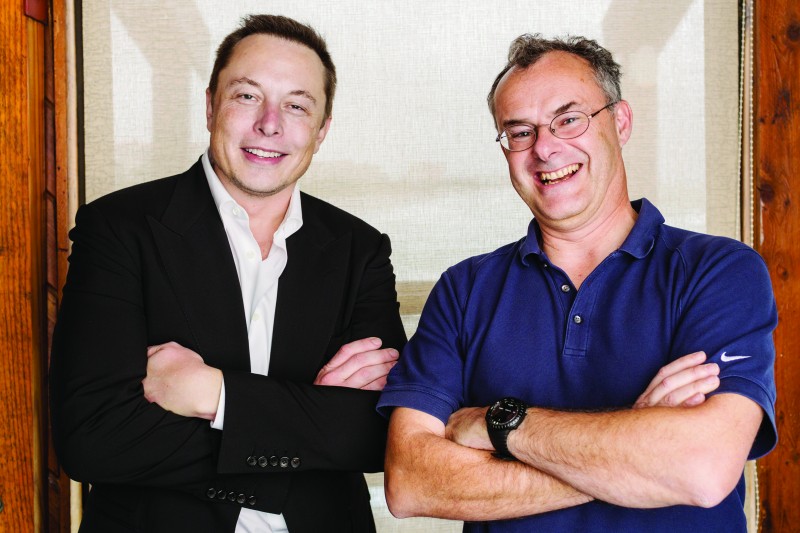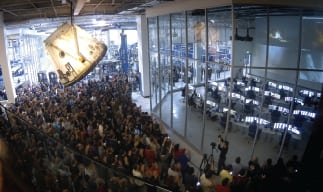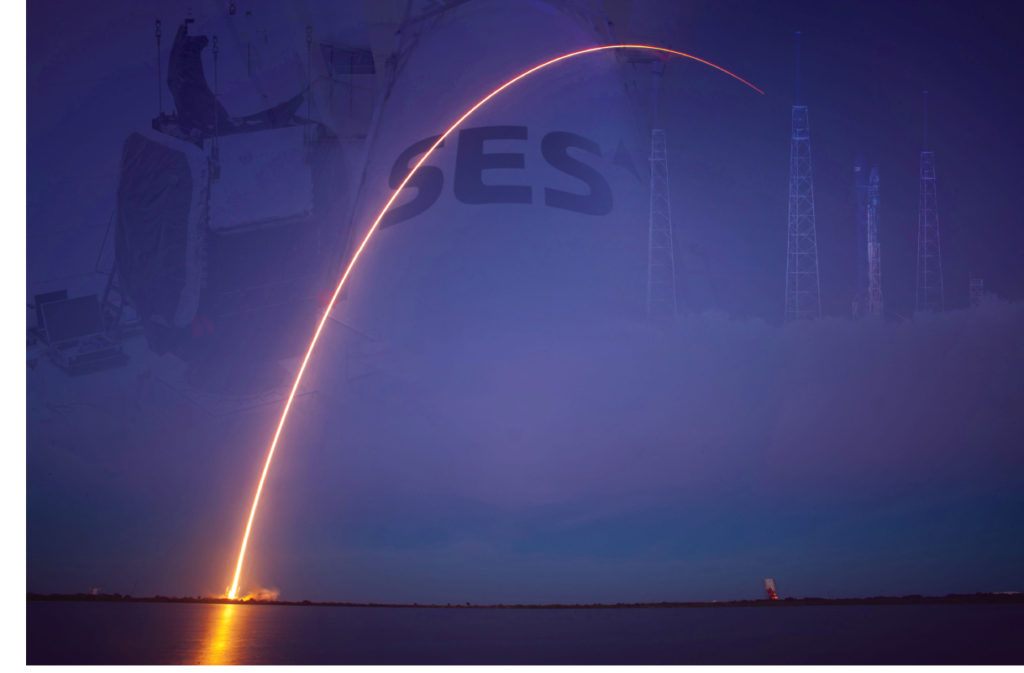Latest News
Read this article in its interactive format!

Elon Musk, SpaceX’s president and chief designer, and Martin Halliwell, SES’ CTO at Cocoa Beach, Fla. before the launch. Photo: Toby Smith, Getty Images.
“At least we still have a satellite,” said Martin Halliwell, CTO of SES, somewhat ruefully, after the first of two launch scrubs of the company’s SES 8 satellite. While he has attended more than 20 launches in his career, this one was different. “The entire commercial space flight world is looking to see the success of this flight,” he said the day before the first launch attempt. What was special about this particular launch was the provider: an 11-year-old company attempting to break through the commercial satellite launch market. The SES 8 launch marked the first time SpaceX launched a commercial satellite into geosynchronous orbit.
“This launch, in my opinion, is probably the most important launch in the commercial arena, certainly since 1996, no doubt about it,” Halliwell said. “There are detractors, who are hoping for a failure, but the majority of the commercial satellite world is waiting for a success because it really opens a whole bunch of opportunities.”
From Disney World to Cape Canaveral
The excitement was palpable on Monday, Nov. 25, 2013 as everyone started to gather at the media checkpoint outside the U.S. Air Force base in Cape Canaveral, Fla. Elon Musk, SpaceX’s CEO and chief designer, wandered around the area taking in the view and fresh air. He had been at Disney World in Orlando, Fla. the previous day as a sort of ritual. “At Disney World w kids for traditional prelaunch visit (first good flight was after riding Space Mountain),” he tweeted on Nov. 24.
Journalists chatted and shared their stories of previous launches at the Cape. There was mostly optimism, although some doubted the success and others turned to superstitions. At around 4:30 p.m., the chatter was interrupted by the lead of the media caravan and we headed out to the viewing site (Causeway E), leaving behind the SES and SpaceX team at the control center.
Just 4 miles away from Space Launch Complex 40, the TV station vans setup their cameras as well as the professional photographers with their huge telephoto lenses. There was a lot of thrill and anticipation at the Causeway, which heightened as the sun began to set behind us. The temperature started to drop and it was very windy. I didn’t know if I was shaking because I was cold or because I was too excited — this, after all, was my first time attending a satellite launch.
The first halt of the countdown occurred around T-13 minutes due to a first stage valve issue. After the clock was restarted, a second hold of the clock occurred about T-6 minutes due to a telemetry issue. Finally, the clock was recycled to around T-18 minutes with a new T-0 at 6:30 p.m. EST. But just at T-00:03:40, the team “observed unexpected readings with the first stage liquid oxygen system so we decided to investigate,” according to a SpaceX statement. Unfortunately, the team’s investigation of this issue ran past the launch window closing time at 6:42 p.m. EST, thus the launch had to be postponed.
The excitement that had built up prior to the launch quickly turned into disappointment. After approximately four hours of getting there, we were all headed back to the exit. “Welcome to my world,” I heard one reporter say. He said he has been covering launches from the Cape for many years so he is well used to going home without feeling the blast of the rocket engines only to come back a few days or weeks later and do it all again.
At the post-launch dinner, however, the mood was not too somber. “[SES] seemed to have a great sense of humor about the whole thing,” said SpaceX’ President and COO Gwynne Shotwell.
“We were pretty cool about the whole thing because launch scrubs are nothing new for us. It’s not unusual to have one or two launch scrubs, then have to come back maybe a couple of days later or maybe a couple of weeks later,” Halliwell said.
However, the scrub was particularly disappointing for SES’ clients from all over the world who were invited to see the launch, as they had to go back home, in a way, “empty handed.”
Spacegiving
The second launch attempt on Nov. 28 coincided with the Thanksgiving holiday in the United States. To add a bit of levity to the event, SpaceX used “spacegiving” as the name for the launch attempt that day. I drove for three hours traversing the entire state of Florida from West to East to be there. This was my last chance; I had to fly back to Washington, D.C. on Friday, with or without a launch.
The experience was much more quiet. The anticipation was palpable but the excitement had faded a bit, as many were not able to return to the Causeway that day. The countdown went down to T-5 seconds. It felt as if everyone at the viewing site was holding their breath as the cold wind dried our eyes fixated on the Falcon 9. There was a loud roar for a fraction of a second and then complete silence. Everyone started looking at each other with confusion. At an anti-climatic T-1 second, the launch had been aborted.
“We had low-power conditions on a number of the engines on the first stage and so we did an autonomous abort; the launch abort system worked exactly right,” Shotwell said.
There was still time during that launch window and SES even approved an extension of a few minutes. The clock was recycled but the general feeling around the Causeway was not very optimistic. Then, at T-60 seconds, the launch was finally scrubbed, calling for a rescheduling in a few days.
“There was just more work and more data we wanted to go through to make sure we were really ready to lift off,” said Shotwell. It was another sad post-launch dinner but this time a bit of frustration had started to build and, while no one said it out loud, it was clear there was some concern. I was particularly disappointed to go back to D.C. the next day without having witnessed this historic launch after a week of anticipation and late nights.
As the SpaceX team assessed the issues once again, SES tried to remain pragmatic about the situation. “For us the most important thing is you haven’t lost a satellite, you haven’t lost a rocket, everything is still ok; we still have a good chance of being successful. Of course there’s a bit of an emotional downturn at the end of it but it’s not catastrophic,” Halliwell said.
Being the maiden flight of a launch vehicle is nothing new for SES. Back in 1996, the company was also the first commercial satellite launch aboard a Proton, a vehicle traditionally used for launching Russian spacecraft, which are very different to western satellites.
For me, spacegiving was all or nothing. As the launch was again scrubbed, I had to leave Florida and head back north. Next time I’d have to watch the webcast.
Third Time’s a Charm

SpaceX employees watch the Falcon 9 SES 8 launch from the company’s headquarters in Hawthrone, Calif. Photo: SpaceX
After two dramatic launch scrubs, the simplicity of the final launch on Tuesday, Dec. 3 was almost surprising. The countdown went smoothly with no holds as I ate my popcorn to add some excitement to the experience. At 5:41 p.m. EST, SpaceX’s Falcon 9 ignited its booster carrying the SES 8 satellite into GTO 31 minutes after lift-off. Even though I wasn’t there that time, being on site for the first two scrubs created a special bond for me with this launch. I’ve seen many other launches from my computer but, this particular one was very exciting — even if I didn’t really feel the roar of the engines.
“The company went absolutely elated when it was clear we put SES 8 where it needed to go. It’s the first time we had done that and it was quite a high here at the factory. It was great,” Shotwell said. “I feel like for SpaceX things have always happened in the time that they needed to happen and we needed those attempts to learn more about how to operate this system and we learned it and we made mission.”
For SES, it was a moment of relief. “I would say the word was euphoric … Every time you have a first-time mission, it’s something new, it’s something really, really emotional. It was a huge excitement, everybody was cheering,” Halliwell said. “I think the one feeling was a feeling of relief. Everybody just felt ‘wow’ it’s a weight off our shoulders, we’re there, we’re successful and everything is going fine. Huge excitement.”
While seeing the rocket finally lift off was exciting, the real decisive moment was the upper stage’s reignite. During the demonstration flight of the redesigned Falcon 9 v1.1 vehicle that carried the Canadian CASSIOPE satellite to low-Earth orbit, the second stage of the Falcon 9 v1.1 failed to reignite. While this was not necessary for the CASSIOPE mission, it was a critical part of the success for getting the SES 8 satellite to an 80,000-kilometer altitude, about 26,000 kilometers above the GEO, according to Musk.
Approximately 185 seconds into flight, Falcon 9’s second stage’s single Merlin vacuum engine ignited to begin a 5-minute, 20-second burn that delivered the SES 8 satellite into its parking orbit. Then, 18 minutes later, the second stage engine successfully relit for just more than one minute to carry the satellite to its final geostationary transfer orbit in what SpaceX called a “picture-perfect flight.”
The SES 8 was then handed over to SES’ operation team. With five burns of the liquid apogee motor, the satellite has reached its final geostationary orbit and has deployed the solar arrays and the reflectors. The spacecraft will be ready to begin commercial operations on Feb. 1, according to Halliwell.
Shaking the Industry to its Roots

Falcon 9 and SES 8 launch from SpaceX’s launch pad at Cape Canaveral, Fla. in what SpaceX called a “picture-perfect flight.” Photo: SpaceX
The successful SES 8 launch is likely to mark a new era for the satellite industry. “The entry of SpaceX into the commercial market is a game changer, it’s going to really shake the industry to its roots,” Halliwell said. “We think this is the way to go forward for the future.”
And this is mainly because SpaceX is aiming to position itself as the low-cost provider within the commercial satellite launch market compared to established players such as Arianespace and ILS. “In order for the other launch companies to compete, they therefore will have to improve their designs and really strive to have next-generation rocket technology,” said Musk.
Because this was its maiden GTO flight, SES got a “substantial” discount to the baseline $56.5 million price, making it an even more compelling deal for SES
“Spacecraft are getting more expensive, the revenues going down, the gap is getting bigger. We have to look then where can we save money, where can we actually revert this. One of the things we were looking at is with the launch and this is really why we said ‘Ok, SpaceX is a possibility,’” Halliwell said.
However, it is not only on pricing where SpaceX aims to be different. Shotwell sees a major difference in the business models.
“Arianespace is kind of a sales and customer support framework that sits in front of Astrium, which basically builds the Ariane 5 launch vehicle. ILS is the same similar kind of customer service organization that gets their rockets form Russia. SpaceX is different because we are the customer’s sales face but we build our own rockets,” she said. “We build the vast majority of the rocket.”
This means that if any issue comes up during a launch campaign with the vehicle, SpaceX is prepared to respond in real time. This was something that really caught Halliwell’s attention. “With the other launch providers that could have taken a considerable amount of time but SpaceX really looked to the problem, understood the issues, brought the people in, address the issues and fix them real time there and then,” he said. “That’s something pretty unique in the industry, I’ve never seen that before. That was very, very good.”
Shotwell added, “One of the critical differentiators I think that SpaceX… is that when we have issues — because rockets are complex machines and you’re always going to have issues — we don’t need to go find the people back at the supplier of whoever built the rocket to come help us on the launch pad. This is our rocket, the engineers that designed that system were standing underneath that rocket, working hand in hand with our technicians that built the rocket to go ahead and work on those engines. Our ability to turn issues around quickly, it will be unsurpassed.”
The Beginning of a Long-Term Relationship
“We’ve had extraordinary access to the analysis work that has been done,” Halliwell said. Due to ITAR restrictions only U.S. citizens from SES’ team were allowed to gain insights of the launch vehicle. “They could not tell me the outcome of the meeting, all they could do was come with a recommendation of ‘yes, we’re good to go’ or ‘no, we’re not good to go;’ they couldn’t give me the details,” he says adding that, SES’ team of U.S. citizens were “embedded together with the SpaceX propulsion team and it’s been able to retire an awful lot of risk associated with this and it’s given us a real feel good character,” he said. “We crawled all over [the Falcon 9 v1.1], believe me, and we’re happy.”
This close relationship between SES and SpaceX was key to the success of this mission as it allowed both teams to collaborate and make sure that every detail of the process met the requirements of both parties.
“What is interesting with SpaceX, whenever they had a problem, we had quite a lot of visibility into it. We’ve had the opportunity to be able to work together with them, which is relatively unusual,” he added. “It’s a long-term relationship with these guys,” Halliwell added.
Both Halliwell and Starkovs emphasized that their trust was based on the open relationship with SpaceX, which allow them to experience first hand, all the efforts the team made.
“We’re very appreciative that SES would place their faith on SpaceX. One thing I can say with certainty is that we’ve done everything we could possibly think of to maximize the probability of success for the mission,” Musk said before the first launch attempt. “The policy of SpaceX is, right up until the launch takes place, if anyone has any unresolved concerns, they can email me directly, and we’ll put a hold on the launch and resolve whatever that issue might be.”
One Launch, Many Milestones
The SES 8 launch was important to SpaceX not only because it was it’s first commercial satellite launch to geosynchronous orbit, opening a flurry of new business, but also because it counted toward the certification process for the U.S. Air Force’s Evolved Expendable Launch Vehicle-class (EELV) program, according to Shotwell. Obtaining this certification will allow SpaceX to compete with United Launch Alliance (ULA) for national security payload launch contracts.
A successful launch with SpaceX potentially opens up a number of new possibilities for SES also. “The big push that we’re looking for at the moment is electrical propulsion, that’s the big game changer again,” Halliwell said. “You’ll be able to launch far more complicated satellites with a much more smaller mass and that’s when SpaceX really starts to come into its own.”
Get the latest Via Satellite news!
Subscribe Now